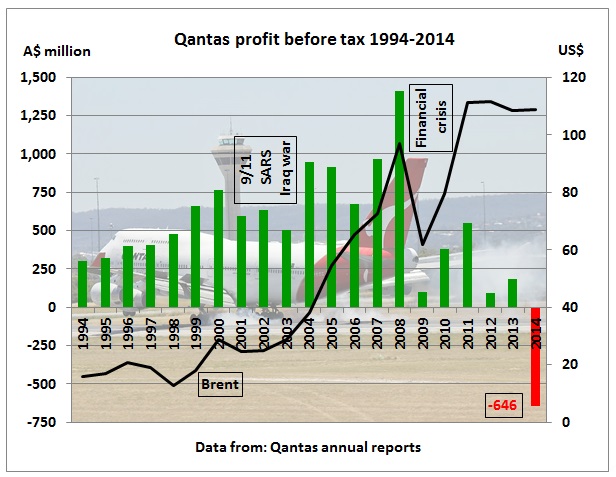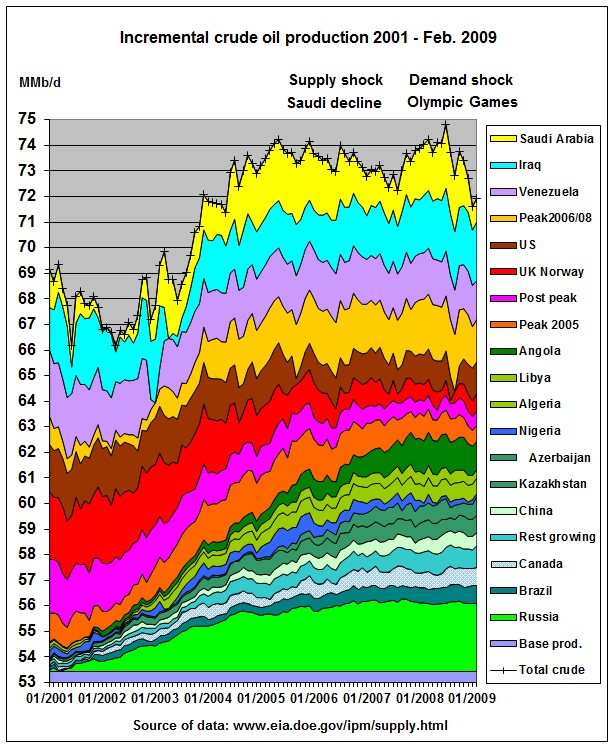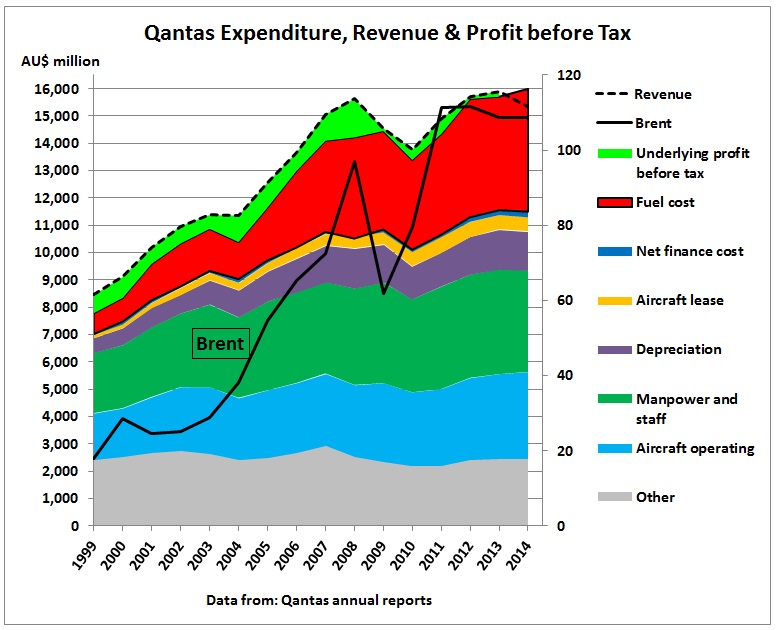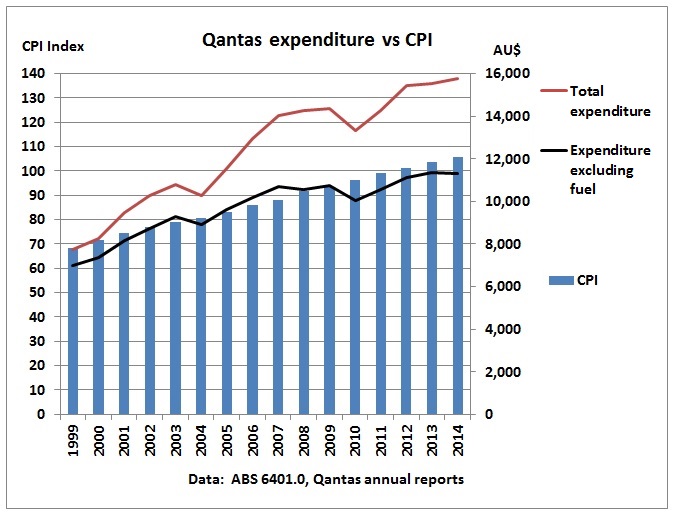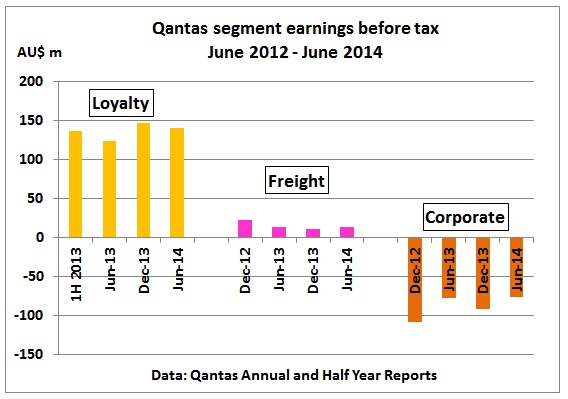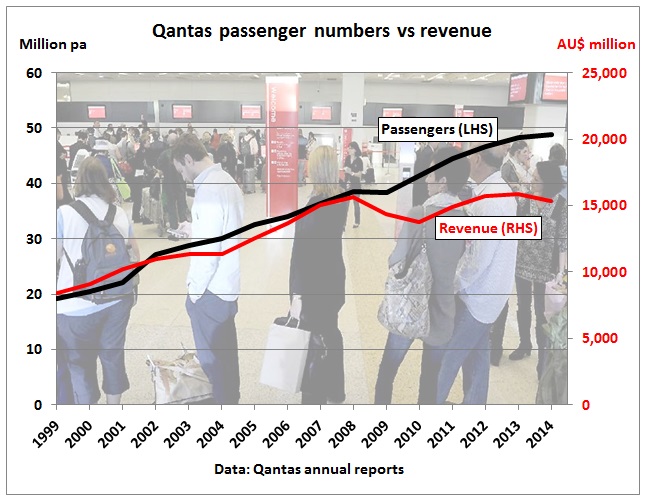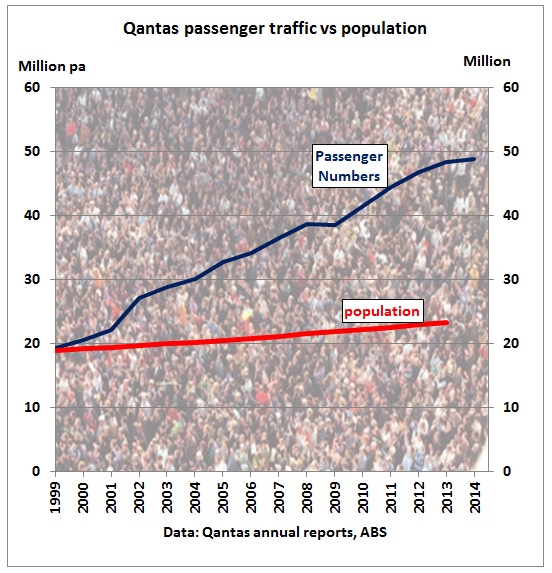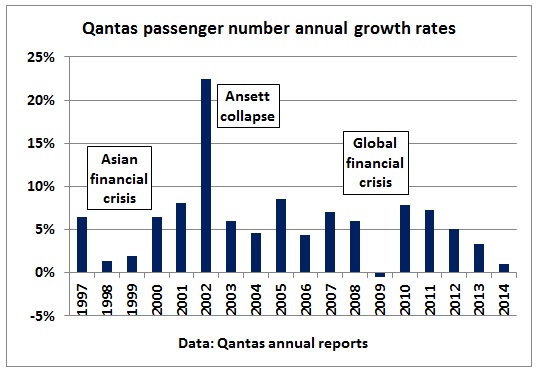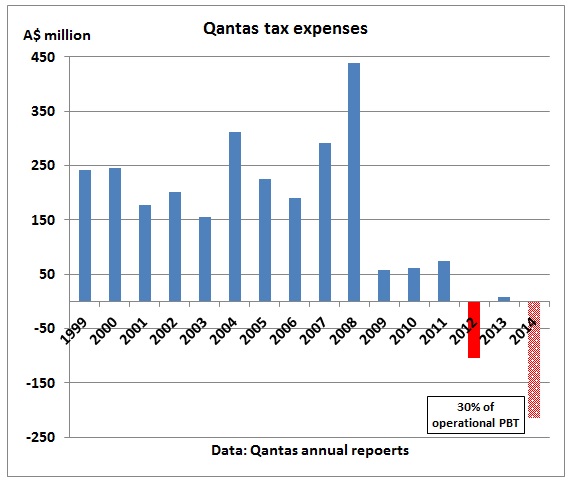A lot has been written about Qantas’ FY 2014 losses of AU$2.8 bn but no analysis was done by the main stream media how the timeline of these losses are connected to the peaking of global crude oil production. This post is an update to 3 previous posts The end of airlines – predicted by no other than former Qantas CEO Geoff Dixon in July 2008, Qantas fuel cost increased 3 times more than seat kms and Qantas hit by invisible hand of peak oil
Turning point Financial Crisis and 2008 Oil Price Spike
Fig 1: Qantas profits before tax 1994 – 2014
The graph shows that the turning point for profits was 2009 with the 1st phase of the financial crisis which was triggered by the convergence of accumulating debt and an oil price spike in 2008. Crude oil production declined between 2005 and 2007, causing a recession in the US in late 2007 (supply shock). In 2008 there was a demand shock caused by China’s Olympic Games.
Fig 2: Incremental crude oil production between Jan. 2001 and Jan. 2009
The combination of a supply and demand shock was like a heart attack or stroke with permanent damage to the financial system and the economy. More details from literature research can be found in the Appendix. What matters is that physical oil flows must always be sufficient to supply the world’s economy at any given time whatever the circumstances are. US shale oil came too late and hasn’t brought down oil prices anyway (because it is too expensive), but it has prevented oil prices from rising further by reducing US oil import requirements – at least for the time being. But for airlines oil prices are now too high for too long which has eroded profits.
Changes of cost structure
Fig 3: Expenditure by type vs revenue
Profits in the airline industry are wafer thin in the best of times. The impact of rising fuel costs on total expenditure is clearly visible. Up to 2008, these additional costs were paid for by an increase of revenue. Profits remained normal, with a record result in 2008 itself. But then revenues were insufficient to pay for ever increasing fuel costs. In 2014, revenues dropped by 3.5% and profits turned to losses.
Expenditure vs CPI
Fig 4: Expenditure vs. CPI
Expenditure excluding fuel went up more or less according to general inflation as measured by the Australian Statistical Bureau http://www.abs.gov.au/ausstats/abs@.nsf/mf/6401.0 It is very clear that it’s the cost of fuel which is damaging the airline business. This belies the assumption of many transport planners that higher oil prices will be absorbed in the CPI and we’ll be alright.
Fuel cost and available seat kms
Fig 5: Fuel cost vs. available seat kms (ASK)
Fig 5 compares rising fuel costs with available seat kms which is the main physical output of an airline. The gap between these 2 curves has been widening again since 2010 when average annual oil prices exceeded the levels reached in 2008.
Seat factor
Fig 6: Seat factor, revenue passenger kms (RPK) vs available seat Kms (ASK)
The seat factor improved until the turning point of 2008 but then steadily declined. In the last 2 years available seat kms increased by 1.6 % but revenue seat kms declined by -1.8 %.
Revenue by segment
Fig 7: Qantas revenue by operating segment
Despite splitting up Qantas into Jetstar, Qantas International and Qantas Domestic, revenue from passenger services in 2014 was not higher than in 2008.
Let’s zoom into the last 2 years:
Fig 8: Earnings in Domestic, International and Jet-Star Segments
In all 3 of the above segments there was a downward trend in earnings.
Fig 9: Earnings of Segments Loyalty, Freight and Corporate
Loyalty is the only well performing segment. Freight is also on the plus side but its size is small
Passenger numbers
Fig 10: Passengers pa vs revenue pa
This graph suggests a perpetual growth in passenger numbers. But revenue is stagnant since 2008. This is not sustainable. Obviously Qantas is in a catch 22 situation. Investors and governments want to see growth in passenger numbers but passengers are simply not prepared to pay for rising costs faced by airlines.
So where does all this growth come from? Is it population growth?
Fig 11: Qantas passenger numbers vs. population
We see that the number of flights per capita has doubled between 1999 and 2013. This cannot continue while revenue is flat. If air fares go up to increase revenue, passenger numbers will drop.
Fig 12: Qantas and Jetstar domestic & international passengers
The domestic growth in 2002 was due to Qantas taking over passengers from Ansett which collapsed in Sep 2001, the month of the WTC attack. All growth after that took place in low cost Jetstar. Domestically, 43% want to fly, but on the cheap. That won’t last long. The Sydney Morning Herald writes:
30/8/2014
Airline capacity war over as clock ticks on cheap tickets
Fig 13: Qantas annual growth rates (passengers)
The average growth rate was 5% for the period 2003-2014. 5% is the global average 2010-2014. Since the post GFC rebound, Qantas growth rates have been going down for 5 years now. The news of Australia’s declining revenue seat kms has also reached the IATA headquarters:
| July 2014 vs. July 2013 | RPK Growth | ASK Growth | PLF |
| Australia | -1.6% | -0.3% | 77.7 |
| Brazil | 0.7% | -3.0% | 81.9 |
| China P.R. | 8.8% | 8.9% | 80.6 |
| India | 6.0% | 8.3% | 69.4 |
| Japan | 4.6% | -3.3% | 65.4 |
| Russian Federation | 9.9% | 6.3% | 85.1 |
| US | 3.9% | 1.9% | 88.5 |
| Domestic | 4.9% | 3.5% | 83.0 |
RPK=Revenue Passenger Km, ASK=Available Passenger Km, PLF=Passenger Load Factor
http://www.iata.org/pressroom/pr/Pages/2014-09-03-01.aspx
Tax payments
As shown in an earlier post, 60% of the Federal debt since 2008 is the result of lower company tax. Qantas is a good example:
Fig 14: Tax paid by Qantas
Less profits before tax (Fig 1) mean less taxes paid. A dramatic drop can be seen after 2008. Negative values are future tax benefits which can be realised in case Qantas becomes profitable again. For 2014 only the operational part of the losses has been included. We see that the government can’t expect to collect taxes from Qantas any time soon.
Implications for airport planning
Despite Qantas’ losses and lack of tax revenue the Federal governments still wants to build a 2nd airport for Sydney.
Western Sydney airport: Notice to Consult issued today
18/8/2014
The Australian Government’s delivery of a Western Sydney airport by the mid-2020s reached an important stage today, with the Australian Government today formally issuing a Notice to Consult to the Sydney Airport Group.
Under the 2002 Sydney (Kingsford-Smith) Airport Sale Agreement, the owners of Sydney Airport have a Right of First Refusal, which gives them first opportunity to develop and operate a second major airport within 100 kilometres of Sydney’s centre
http://www.minister.infrastructure.gov.au/wt/releases/2014/august/wt140_2014.aspx
While writing this article the Assistant Minister for Infrastructure warned Sydney Airport that if it delays the process of building an airport at Badgerys Creek the government will find another partner to help build the project. Good luck.
The lack of sense for reality is astounding. A lot of tax-payer’s money has been and still is being wasted for planning of this white elephant.
Conclusion
The end of the era of cheap oil means the end of the era of cheap air fares. After a couple of years of trying to offset higher fuel cost by both cost cutting and capacity expansion the strategy of perpetual growth is in doubt. The next challenge will come with the next oil price spike cum credit crunch which is certain to come in the next years as US and Russian crude production are likely to reach their 2nd and last peak simultaneously all the while the Middle East is disintegrating in front of everyone’s TV eyes.
Appendix
(repetition from earlier posts but this must sink in)
It is important to understand the following 3classical articles because the media are still not connecting the dots.
(1) Causes and Consequences of the Oil Shock of 2007–08
James D. Hamilton
Spring 2009
“Whereas historical oil price shocks were primarily caused by physical disruptions of supply, the price run-up of 2007-08 was caused by strong demand confronting stagnating world production. Although the causes were different, the consequences for the economy appear to have been very similar to those observed in earlier episodes, with significant effects on overall consumption spending and purchases of domestic automobiles in particular. In the absence of those declines, it is unlikely that we would have characterized the period 2007:Q4 to 2008:Q3 as one of economic recession for the U.S. The experience of 2007-08 should thus be added to the list of recessions to which oil prices appear to have made a material contribution.”
http://muse.jhu.edu/journals/brookings_papers_on_economic_activity/v2009/2009.1.hamilton.html
(2) The Global Financial Crisis:
Causes and Consequences
Nov 2009
Warwick J McKibbin and Andrew Stoeckel
“Rising demands from China (and, to some extent, India), plus a booming world economy
saw commodity prices rise across oil, minerals and food from late 2004 to late 2007. The
shock to the global economy from this commodity price boom was as big as the first oil
shock in the 1970s”
http://melbourneinstitute.com/downloads/conferences/mcKibbin_stoeckel_session_5.pdf
(3) Financial Crisis of 2007–2010
Winston W. Chang
Department of Economics
SUNY at Buffalo, NY 14260
September 24, 2010, Revised: June 30, 2011
“Following the collapse of the housing bubble the global commodity market entered its own bubble. From early 2007 to mid-2008 oil prices skyrocketed from $50 to $140 a barrel then plunged to $30 by the end of 2008. The bubble has been attributed to the flight of capital from the housing market, pure speculation, increasing concern over the limited supply of natural resources and increased demand from growing, resource-hungry economies in Asia. With more money flowing to oil producing nations, economic growth in the rest of the world suffered under the increased cost burden.”
http://papers.ssrn.com/sol3/papers.cfm?abstract_id=1738486
Fig 15: China’s oil demand ahead of the Olympic Games
Demand shock in mid 2008: China went on the oil market with an additional 800 kb/d in preparation for the Olympic Games. The supply was forthcoming at a record price, mainly from Saudi Arabia which increased production from 9.2 mb/d in Jan 2008 to 9.7 mb/d in July 2008, just short of a theoretical maximum capacity of 10.9 mb/d. The new AFK field project was not fully operational at that time and Saudi production immediately dropped by 1.2 mb/d once demand eased, to avoid overproducing fields. In fact, Matthew Simmons’ 2005 warning in his book “Twilight in the desert, the coming Saudi oil shock and the world economy” had materialized in 2008. Saudi Arabia’s inability to produce oil quickly enough hit a financial system with a pre-condition of accumulated debt.
